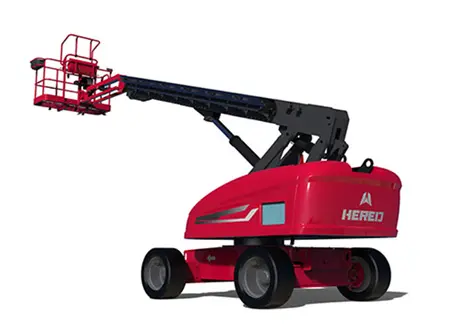How to Choose a Telescopic Boom Lift?
Telescopic Boom Lifts are elevating work platforms with boom sections that extend telescopically and feature greater horizontal outreach than any other type of aerial platform. Perfect for use when operators encounter different and difficult angles, our range of telescopic boom lifts will get you exactly where you need to be by providing maximum horizontal and vertical outreach. It is also designed to boost productivity, with the ability to get into a working position quickly and easily.
Evaluate the size of the platform
You should not try to carry anything on a telescopic boom lift that is larger than the platform, even if what you have is relatively light. Without checking the size of the platform, you will not know if the tools or equipment you plan to lift can be safely mounted there. Try to choose a telescopic boom lift with a platform that is large enough to put everything you need on it at once so you don't have to waste time lifting platforms to switch equipment.
For example, a 120-foot-tall telescopic boom lift will have a platform that is 96 inches long by 36 inches wide or about 8 feet long by 3 feet wide. Wider platforms usually have a lower weight capacity because they are heavier. The shape of the platform will also have an effect on the center of gravity of the telescopic boom lift. Different telescopic boom lift heights represent different load capacities and platform sizes.
Consider the working area
Telescopic boom lifts usually run on diesel or dual fuel. You should not use a telescopic boom lift indoors without adequate ventilation. Fumes from exhaust fumes can cause carbon monoxide poisoning or other health problems. Electric telescopic booms are usually the quietest and best suited for indoor work. However, they are not as powerful as most gasoline, diesel, or propane engines.
Whichever fuel type you choose, make sure the floor or ground surface can support the weight of the telescopic boom lift. Check the class rating of the cantilever lift you are interested in. Without the correct rating, you may not be able to safely climb or descend hills near your job site.
You should also make sure that the telescopic boom lift you choose has a stable base and tires that are suitable for the terrain. Many telescopic boom lifts have wide bases that provide extra stability and four-wheel drive. The extra stability can be used in rough areas, but it will increase the footprint of the telescopic boom lift you choose.
Many telescopic boom lifts have power outlets on the platform and generators on the base to run a variety of equipment. These generators can provide AC or DC power for many applications. Air and water lines can also be connected to the boom platform for activities such as pressure washing. If you think you need to navigate with many tools or debris, look for cantilever lifts with high ground clearance. Some models have tracks rather than tires to help them get through mud or snow.
Check out the safety components
Choosing the right telescopic boom lift is critical to your safety. An elevator that's too big may hit power lines, low roofs, and other obstacles, but one that's too small won't get your equipment and workers where they need to be. Make sure you are familiar with safety laws and regulations. The Occupational Safety and Health Administration (OSHA) enforces U.S. safety laws, including those for telescopic boom lifts. Only trained, authorized personnel should operate telescopic boom lifts. In the event of an accident, if you find a new workplace hazard, or if you decide to use a different type of aerial lift, you should retrain your workers.
HERED constantly promotes innovation in product research development. At present, a number of patents including self-propelled ash sprayer, protection unit of scissor arm, hole protection device of scissor lift, platform weighing mechanism of AWP, power system rough terrain scissor lift is being successively applied for. If you want to get more information about the best telescopic boom lift wholesale, welcome to contact us today or request a quote.




